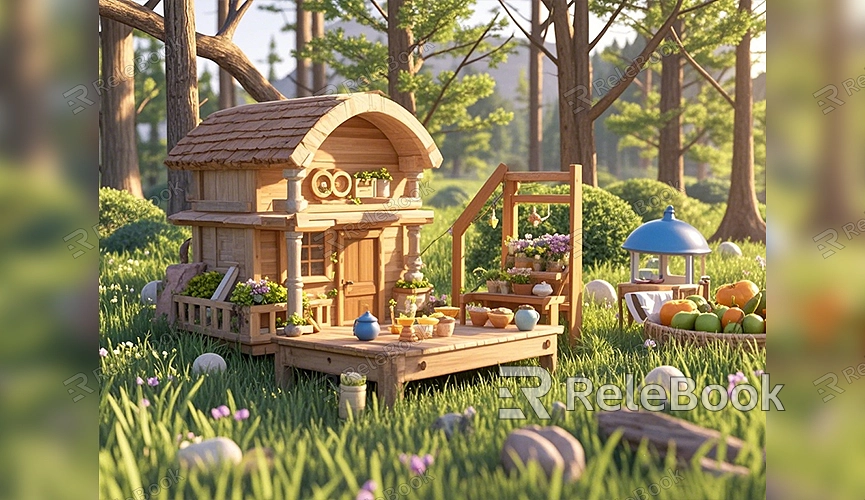How to render environment in blender
Rendering realistic environment scenes in Blender is a crucial step in creating immersive visual experiences. Whether it's a natural landscape, an urban setting, or a fantasy world, a lifelike environment scene can greatly enhance the value of your work. This guide will delve into how to render environment scenes in Blender, covering key steps such as scene building, material application, lighting setup, and rendering optimization.

Scene Building and Model Selection
The first step in rendering an environment scene is to construct a well-organized scene structure. Depending on your project needs, choosing the right models to build the scene framework is essential. Blender offers a wide range of modeling tools that allow you to create terrain, buildings, and other scene elements directly within the software. Additionally, you can import high-quality 3D models from external libraries to quickly assemble complex environments.
For example, if you're creating a forest landscape, you can use Blender's vertex painting tools to create terrain variations, and then generate trees and shrubs using the particle system. You can also enrich the scene by importing rocks and water models from external sources. During the construction process, pay attention to the placement and proportions of the models to ensure the scene appears natural and harmonious.
Material Application and Texture Handling
Materials and textures are critical to the realism of an environment scene. Start by selecting appropriate materials for each element in the scene and applying texture maps to enhance detail. For instance, the terrain can use a soil material with a normal map to simulate rough, uneven ground. For buildings, concrete or stone textures can be used to add texture and depth.
When handling textures, be mindful of resolution and seamlessness. High-resolution textures can significantly improve the clarity and detail of the scene, but they also increase render times and resource consumption. Therefore, it's important to choose texture resolutions wisely and optimize texture sizes. If you need high-quality 3D textures and HDRIs for your models and virtual scenes, you can download them for free from [Relebook](https://textures.relebook.com) to greatly enhance your scene quality.

Lighting Setup and Environment Lighting
Lighting is one of the core elements of rendering environment scenes. In Blender, the lighting setup directly affects the atmosphere and depth of the scene. Generally, natural scenes can use Sun Lamps and HDRI environments to simulate realistic daylight, while urban environments may combine multiple point lights to create complex light and shadow effects.
When using a Sun Lamp, you can adjust the angle and intensity of the light source to simulate lighting effects at different times of the day. For example, low-angle sunlight can create long, soft shadows, suitable for morning or evening scenes. HDRI lighting, on the other hand, can provide full-spectrum lighting, ensuring that every corner of the scene is filled with detail. If you need high-quality 3D models to build complex environments, you can download them from [Relebook](https://3dmodels.relebook.com). Relebook offers a wide range of premium 3D resources that can help you complete your scene construction faster.
Rendering Settings and Performance Optimization
Optimizing rendering settings is crucial to producing high-quality environment scenes in Blender. First, increasing the sample count can effectively reduce noise, enhancing the detail in your render. Additionally, enabling anti-aliasing will smooth out the edges of the scene, preventing jagged lines.
When rendering complex scenes, using distributed rendering can significantly reduce render times. Blender supports distributing rendering tasks across multiple computing nodes to improve efficiency. Moreover, managing memory and processor resources to prevent overloading a single node can further optimize the rendering process.
Finally, after rendering, you can use Blender's post-processing tools for fine-tuning. Adjusting color, contrast, and light intensity can make the scene look even more realistic and vibrant.
Rendering environment scenes in Blender is a complex yet creative process. By properly building your scene, applying materials and textures, setting up lighting, and optimizing render parameters, you can create realistic environmental effects that add immersion and visual impact to your work. I hope this guide helps you become more proficient in Blender's environment rendering techniques, making it easier to create high-quality virtual scenes. If you need high-quality 3D textures and HDRIs for your models and virtual scenes, you can download them for free from [Relebook](https://textures.relebook.com) to greatly enhance your scene quality. If you're looking for premium 3D models, you can download them from [Relebook](https://3dmodels.relebook.com), where you'll find a wide range of top-quality 3D resources.

